Author: Adam Simmons
Last updated: January 8th 2023
Table of Contents
The rise of LED
LED (Light Emitting Diode) backlights are ‘interesting’ for the consumer as they help make a thinner, lighter and more efficient display. It is also a winner from a marketing perspective, with manufacturers keen to draw an artificial distinction between their ‘LED’ (backlit) monitors and their ‘LCD’ monitors. This blindly leads people to believe that the technology was completely distinct from ‘LCD’ and not just a change in backlight type from CCFL (Cold Cathode Fluorescent Lamp) to LED. The rapid brightness adjustments also allow manufacturers to make better use of the ‘dynamic contrast’ feature that we often criticise in our reviews. The practicality of adjusting the entire backlight to suit the overall scene darkness is questionable. But it certainly allows the insanely big and misleading numbers game to be played with contrast ratios.
To many consumers the situation seemed win-win with the end product being thinner, lighter, free from mercury and arsenic and more energy efficient – consuming less power and generating less heat. Looking deeper into the monitors using the technology, as they became more prevalent, it soon became clear that there was still room for CCFL backlighting. The drive to make things thinner may please some users aesthetically, but it also has its downsides. Although manufacturers have largely moved past this as a key selling point, some LED-backlit models are particularly thin and susceptible to being flexed both during and after manufacture. This can exacerbate luminance uniformity problems and in particular cause issues with backlight bleed and clouding. The main drawback of earlier LED backlight technologies relates to the narrower spectral range of the light they emit when compared to WCG (Wide Colour Gamut) CCFL backlights. This was a key reason for some manufacturers being slow to drop CCFL backlighting on some of their ‘professional’ models – almost exclusively to create wider colour gamuts necessary for image processing and viewing extended colours gamuts such as Adobe RGB. Despite these potential drawbacks the technology was adopted as ‘standard’ by many manufacturers, primarily for ecological reasons and to suit the majority of the market. As an Amazon Associate I earn from qualifying purchases made using the below link. Where possible, you’ll be redirected to your nearest store. Further information on supporting our work. A fairly narrow selection of LED-backlit monitors actually overcame the colour gamut limitation (and then some) by employing ‘triads’ of LEDs (red, green and blue) to create broad-spectrum white light. This rare alternative to WLED (White Light Emitting Diode, the common implementation explored below) was known as RGB-LED backlighting. Some notable models include the XL20, XL24 and XL30 from Samsung, a manufacturer who were amongst the first to broadly introduce LED backlight technologies to both monitors and TVs. Although RGB-LED designs flaunted colour gamuts that even WCG-CCFL backlights couldn’t generally reach the technology never really took off. There were simply too many drawbacks; cost, size, weight, differential degradation of the LEDs (leading to colour imbalances across the screen over time) and relatively poor energy efficiency. Unlike these RGB triad designs, most modern LED backlight solutions involve placing a border (or in some case clusters) of ‘white’ LEDs behind or at the side of the LCD matrix, often near the edges and using a diffuser to spread the light across the screen. Despite being called ‘white’ LEDs they actually emit a blue light which passes through a yellow phosphor to give a more neutral white and provide the red and green components of the image. Early iterations of the technology (those circa 2009-10) tended to suffer from an obvious and uncorrectable blue bias. As manufacturers became more familiar with the technology and were able to tweak the backlights, phosphor coatings and the LCD panels this tint became more workable. Despite these advances many WLED backlights used in modern monitors still suffer from certain imbalances when it comes to the spectrum of light they produce. The graphic below represents the relative intensity of light at various wavelengths for a ‘typical’ modern WLED backlight. You can see a distinct peak of spectral energy in the ‘blue’ region, specifically ~450nm (light considered ‘pure blue’). This comes from the blue diode of the backlight which is typically composed of InGaN (indium gallium nitride). A much weaker spectral response of less than a third the intensity can be observed between 500nm and 700nm, corresponding to the ‘yellow’ light of the typical scintillator phosphor coating; YAG (yttrium aluminium garnet). In combination the InGaN and YAG components of the backlight produce ‘white’ light with a native colour temperature (white point) determined by the ratio of InGaN to YAG. This light is filtered through the red, green and blue subpixels of the monitor to produce a wide range of colours and allow further refinement of the white point. After filtering a considerable amount of the initial spectral energy of the backlight is lost; the ‘filter’ is far from perfect and the initial spectral imbalance of the backlight is still an underlying issue. Provided the filters are working as intended (i.e. the monitor is properly calibrated) your typical WLED-backlit monitor will be able to make good use of the strong ‘pure blue’ spectral component to produce strong ‘pure blue’ colours. The red and green components (originating from the yellow light of the YAG phosphor coating) are relatively weak. These gaps in spectral energy and relative lack of intensity for wavelengths other than ~450nm restrict the colour gamut of a typical LED-backlit monitor to roughly the sRGB colour space. The colour gamut shown below compares the Dell U2412M’s colour gamut (red triangle) with the sRGB colour space (green triangle). Although the U2412M is now quite dated, this sort of colour gamut is rather typical for current models with 1920 x 1080 (Full HD) resolutions in particular. Looking at the colour reproduction in greater detail you will also find that the ‘pure blue’ component can become overpowering. When you mix this with the relatively diminutive yellow component (greens and reds) there will be some weaknesses evident. This is particularly true for shades that are mostly blue but contain a slight mixture of the other colours; it may seem counter-intuitive but most WLED-backlit monitors are not very good at displaying certain shades of blue! It is a similar story for many standard-gamut CCFL-backlit monitors when producing green shades. There is typically a spectral peak at green and secondary peaks at blue and red. In this example the peaks at red and blue are 40% the intensity of the green maximum. A crucial point to note, though, is that the relative intensity of these peaks and the distribution of energy for surrounding wavelengths varies considerably depending on the phosphors used. Although it can be nice from some perspectives to reach sRGB or a bit beyond, as it allows slightly greater vibrancy, you would really want to reach the next ‘standard’ of gamut for colour-critical work and to really unlock vibrancy potential. To achieve this initially, LG Display took the approach of using a modified type of WLED backlight called GB-LED (also known as GB-R LED or GB-r LED). Rather than using a blue diode coated in yellow phosphor, the backlights combine blue and green diodes with a red phosphor. As illustrated below, this creates strong and distinct spectral peaks for blue, green and red rather than giving a blue peak and broad ‘yellow’ region. The red peak and relative intensity in comparison to the blue and green peaks depends on the phosphor used. ‘KSF phosphors’ may be used, which provide the characteristic triple peak of red energy shown in a later graph. GB-LED technology has been implemented in various LG AH-IPS (‘Advanced High-performance In-Plane Switching’) panels and also some Samsung PLS (Plane to Line Switching) panels. These are designed to provide 98%+ Adobe RGB coverage and 104%+ NTSC coverage which actually exceeds the 98% Adobe RGB and 102% NTSC typical of WCG-CCFLs. There are a number of monitors now available that use GB-LED backlights, including the Dell UP2716D whose colour gamut is shown above (red triangle) and compared with sRGB (green triangle) and Adobe RGB (purple triangle). Panel manufacturer AU Optronics (AUO) have an alternative method of achieving a wide colour gamut, which they have integrated into some of their AHVA (IPS-type) panels. These use a mixture of red and blue diodes with a green scintillating phosphor (a so-called RB-LED or RB-G LED design). The backlight design of both solutions is somewhat more complex than a standard WLED and demands a bit of a price premium in comparison. For CCFL backlights a wide variety of phosphors can be used including ones that produce a wide colour gamut (WCG-CCFL). Although the spectrum shown previously is fairly typical for a standard-gamut CCFL backlight, there has classically been more variation here than for WLED backlights. But things are moving forward; there are a growing number of exceptions when it comes to the light emitted by WLED backlights and recent developments in LED backlighting technology has started to redefine our expectations of the technology. Samsung, one of the key modern panel manufacturers, was one of the first to really embrace WLED backlighting and was the first panel manufacturer to adopt it universally for all new models. Other major panel manufacturers such as LG Display and AU Optronics have long since followed suit. It is very common for models with 2560 x 1440 (WQHD) or 3840 x 2160 (‘4K’ UHD) resolutions to make use of improved phosphors with enhanced spectral qualities to increase energy in the ‘yellow’ region. These enhanced or ‘doped’ phosphors improve the coverage in the red and green sections of the gamut but also expand the range of blue shades that can be produced. Although such backlights were initially relatively rare on 1920 x 1080 (Full HD) models, there are an increasing number of exceptions. With the advent of HDR (High Dynamic Range) and the target of the DCI-P3 and ultimately Rec. 2020 (BT.2020) colour gamuts, there has been a great push to bring things well beyond sRGB. And it is now possible to do this without going to the expense of a complex backlight solution using additional diodes of an alternative colour. Panel manufacturers such as LG, AUO and TPV have looked to enhanced phosphors as an alternative method of achieving such enhancement. LG Display has coined the term ‘Nano IPS’ to highlight their enhanced phosphor technology used to boost that colour space. More specifically, this uses a ‘KSF phosphor’ layer (or K2SiF6 doped with Mn4, for the chemically-minded) to achieve excellent DCI-P3 coverage of ~98%. The first image below shows the spectral profile of such a backlight, with its distinctive spikes of red energy but relatively low green peak. The second image shows the kind of colour gamut achieved by Nano IPS, with the ViewSonic XG270QG used as an example. The green triangle represents the sRGB colour space, the blue triangle the DCI-P3 colour space and red triangle the monitor’s colour gamut. The Quantum Dots (QDs) are found in their trillions on the film. They can be tuned physically (by alternating their size) to control the wavelengths of light emitted once they are excited by a light source. The blue component is provided in abundance in the light emitted from the diode itself whilst the red and green components are provided by the specially tuned Quantum Dots. This provides the three distinct spectral peaks at ‘blue’, ‘green’ and ‘red’ that are required for coverage of extended colour spaces. The sort of spectrum produced by this system is quite comparable to the GB-LED/RB-LED design, with the addition of an equally ‘pure’ and energetic red peak. This is illustrated by the graph below, provided by Jeff Yurek (Product Marketing Manager of Nanosys). A newer iteration of the technology referred to as ‘Eyesafe QD‘ incorporates blue in addition to red and green QDs into the film. The blue QDs absorb light from the diode and emit blue light at less energetic wavelengths (potentially enhancing viewing comfort). The blue peak is also broadened out, which can enhance the colour gamut in the blue region compared to the use of a traditional diode. To find out more about where the technology stands from a PC monitor perspective we spoke to Jeff Yurek directly. He told us that the initial goal was to integrate QDEF films into portable displays such as tablet PCs but that he hopes to see good interest gather from manufacturers of larger displays, too. Indeed Nanosys Quantum Dot technology has now seen wider adoption in displays from various manufacturers including Acer, ASUS, BenQ, MSI and Samsung. An important attraction of QDEF is its easy integration into existing LCD designs – the film is thinner than a typical sheet of paper and simply replaces existing components. It is also cost-neutral, in contrast to the expensive multi-diode and enhanced phosphor designs currently being employed by LG Display. The ‘naked’ blue diode does not need a separate phosphor treatment and instead passes light through the film which is of comparable cost to the phosphor and diffuser arrangement. Furthermore the film itself has demonstrated suitable lifetime for use in TVs and monitors with an equivalent operating lifetime of well over 30,000 hours (which is comparable to some of the better LED backlights out there today). The primary purpose of QDEF technology is to bring extended colour spaces to the user without compromising the form, cost or function of existing LCD designs. The film is currently designed to provide complete Adobe RGB coverage – with even the longer term HDR (High Dynamic Range) standard of Rec. 2020 in its sights. Excellent coverage of the nearer-term HDR gamut target (strong DCI-P3 coverage) has already been achieved with this technology, in products such as the Philips 436M6VBPAB and ASUS PG27UQ. The colour gamuts below show the Quantum Dot backlight solution of the Acer XB323U GP. As set up ‘out of the box’ or with non-extreme adjustments to colour channels, that model shows peaks of red and moreover green energy that exceed the blue peak. This has potential positive implications for viewing comfort (more balanced spectrum with blue light being the more minor component), whilst providing a generous colour gamut exceeding 100% Adobe RGB. The red triangle shows the monitor’s gamut, the green triangle sRGB and blue triangle DCI-P3. The purple triangle in the second image shows Adobe RGB. The ‘Eyesafe QD’ variant of the technology promises complete DCI-P3 coverage, which expands on the 95% DCI-P3 recorded here and ~97-98% recorded on models like the PG32UQX. With the continuing success of QDEF, Nanosys has developed a range of other related QD technologies as described in their roadmap. This includes QDOG (Quantum Dot On Glass) which coats the glass LGP (Light Guide Plate) directly with Quantum Dots, allowing a slimmer display with fewer layers at potentially reduced cost. And QDCC (Quantum Dot Color Conversion) which replaces the colour filter with Quantum Dots for improved power efficiency, brightness and viewing angle performance. However it’s implemented, the generous colour gamut achieved by such QD technologies gives displays the potential to more closely mimic the sorts of colours we can see in the real world and create scenes which are more vivid and realistic. Providing an enriched and colourful playground for content creators to use and for consumer to enjoy. With the rise of HDR (High Dynamic Range), as we cover shortly, this sort of capability is increasingly important. Another company, based in Manchester in England, has developed a similar solution. CFQD (Cadmium Free Quantum Dots) are a key development of Nanoco and like the QDEF film are designed to be seamlessly integrated into existing LCD designs. The backlight excites the Quantum Dots and together they are able to emit light with very strong blue, green and red energy. As the name suggests, this film is free from the heavy metal cadmium which is used in QDEF – a potential environmental benefit which Nanosys now shares. The Quantum Dots (CFQD) used in the Nanoco films were initially manufactured by The Dow Chemical Company in South Korea under the brand name TREVISTA. As reported by South Korean news sources such as The Korea Times Samsung was set to embrace this technology; indeed they did, for some of their 2015 Quantum Dot TVs. It seems like many manufacturers, they now favour the Nanosys alternative instead. Last but not least there is Massachusetts based firm QD Vision, who we mentioned in our OLED article for their work on fully self-emissive Quantum Dot technology. In the nearer term, they have produced their own Quantum Dot technology called ‘Color IQ’. Rather than a film-based solution, this employs Quantum Dots as a rail (edge optic) that sits between the LEDs and the light guide along the edge of the display. Two closely allied monitor manufacturers, AOC and Philips have incorporated the Color IQ technology into some of their monitors. A key advantage being touted here is the decreased cost of achieving effective Adobe RGB coverage compared to GB-LED and RB-LED. Having tested a model featuring this technology (the Philips 276E6ADSS), we are perhaps inclined to agree with some of what Nanosys claimed in a lawsuit they filed against QD Vision in April 2016. Specifically, they state that QD Vision’s ‘Color IQ’ solution is a “poor imitator” of Nanosys’s own technology (QDEF): “The results speak for themselves. Products using QD Vision’s solution have poor color uniformity, high defect rates in the field and unfortunately, are creating the perception that Quantum Dots are a cheap and inferior quality technology.” Whilst AOC and Philips trialled the Color IQ film, they now favour alternatives such as KSF phosphors and in some cases alternative QD LED solutions (nod towards Nanosys) instead. In order to accurately output this vivid and colourful content, though, the content itself must be specifically written with extended colour spaces such as Adobe RGB in mind. Traditionally, the only sorts of users who can properly take advantage of this are colour professionals, photographers and designers who can create and process broad gamut content. As extended colour gamut capabilities become more common the sRGB boundary becomes something that is emulated rather than a native technological restriction. It is only natural that as devices become more universally capable of properly supporting extended colour gamuts we see a shift away from the confines of the sRGB colour space. Designers, film makers and others in the ‘industry’ that we have spoken to are keen to see this as it allows them to better express their creative efforts and bring the consumer the kind of engrossing entertainment experience they crave. Jeff Yurek reiterated this and pointed out that Pixar Animation Studios, for example, use a massive colour palette for their creations but a lot of the shade detail is missed once it’s scaled down and outputted in sRGB. Adopting a broader colour space isn’t something that will happen overnight and there is certainly the need for the hardware to properly support the sRGB colour space as well. This can be done with some degree of success through emulation modes which are common on wide colour gamut monitors. But there may be some confusion if developers start pumping out content designed to be viewed using broad gamut monitors whilst others are still using a standard gamut. There is certainly a bright light at the end of the tunnel, though. Game and movie developers are now focusing on HDR (High Dynamic Range) support for their content, to be consumed on displays that sport such capabilities. We’re now seeing an increasing amount of content that proudly boasts HDR support. In the display world (which differs from HDR used in the photographic sense) one of the requirements is for expanded colour spaces. The aforementioned Rec. 2020 colour space is the longer-term goal here, but in the nearer term display makers are aiming to support as much of the DCI-P3 (a Digital Cinema Initiatives standard colour space) as possible. And using methods such as those described above, these sorts of displays are becoming much more common. With HDR content being accurately mapped onto this colour space, it expands the palette well beyond sRGB and allows the developers to bring their creations to life in a much more varied and visually pleasing way. It also offers a useful stepping stone before Rec. 2020 can be widely supported. When LED backlighting first took off, manufacturers were all too keen to promote what were essentially misleading or even fabricated performance benefits. As the technology became adopted quite broadly it became all too clear that the situation wasn’t a ‘win-win’ in favour of the slender ‘White LED’ (WLED) backlight. In some areas, particularly colour gamut coverage, CCFLs could offer significant and clearly visible advantages. But LCD panel manufactures have now raised the bar in this respect by employing improved phosphors and alternative diode arrangements to enhance colour gamut. Some interesting developments are also running in parallel with this. Samsung and LG Display alongside various other manufacturers are pressing ahead with alternative technologies to enhance the experience, such as OLED, QD-OLED and fully self-emissive QD displays. These promise enhanced colour gamuts, amazing contrast and excellent responsiveness and are slowly penetrating the sector. But LCD technology still dominates, with current alternatives having their own compromises related to cost, image retention or ‘burn-in’ and subpixel structure. Another interesting technology which has started to spread in the consumer space is the use of Quantum Dots in existing LCD designs; QD LED backlight solutions such as the Nanosys Quantum Dot Enhancement Film (QDEF). As with the use of enhanced phosphors, these solutions provide superior colour performance to current basic LED backlights. Unlike advanced diode and phosphor arrangements these products work in place of the phosphor coatings on simple blue diodes and can be implemented by manufacturers without additional material cost. A key goal is to push the colour gamut far beyond the restrictive sRGB standard. We will see more and more monitors comfortably edge past the cramped sRGB colour space and properly display alternative standards such as Adobe RGB, DCI-P3 and ultimately Rec. 2020 (or something approximating it). Without resorting to overly bulky or power-hungry technologies. This will give content creators the opportunity to really give scenes the look they intend with truly vivid, spectacular and true-to-life colours. Especially as HDR becomes a key content focus for developers. That’s a very exciting prospect for game developers, film producers, artists and designers – and of course the consumer at the other end. As an Amazon Associate and Newegg Affiliate I earn from qualifying purchases made using the below link. Where possible, you’ll be redirected to your nearest store. Further information on supporting our work.
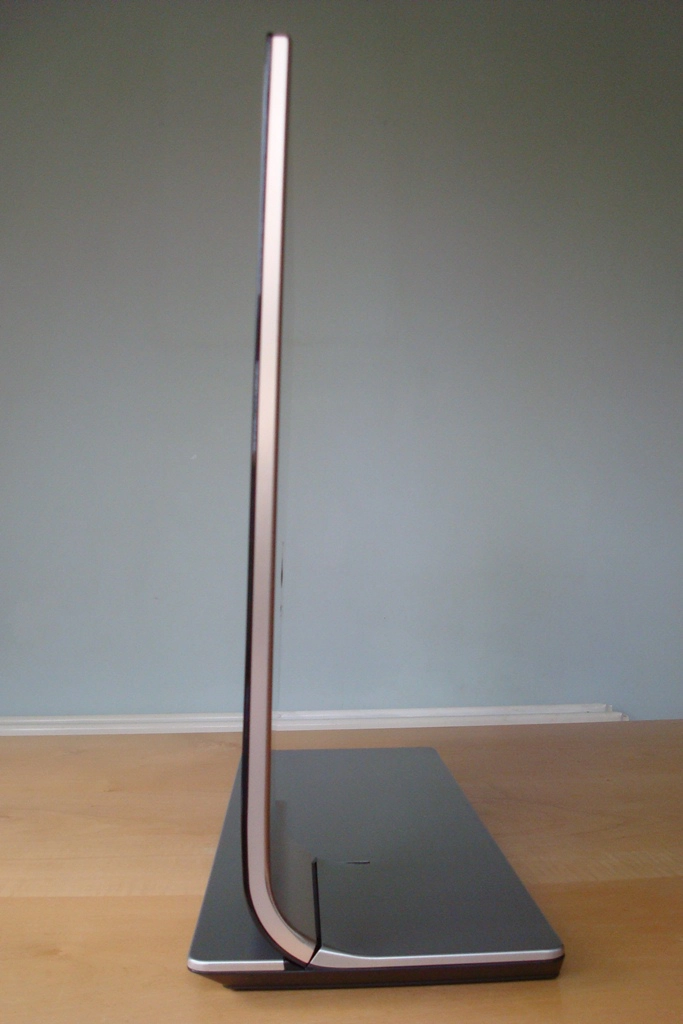
Thin, attractive and relatively delicate
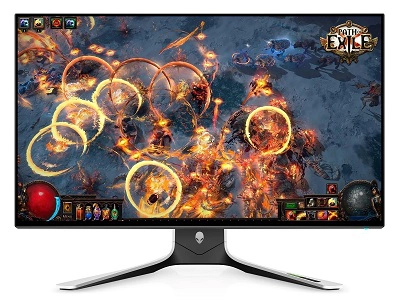
RGB LED – a rare breed
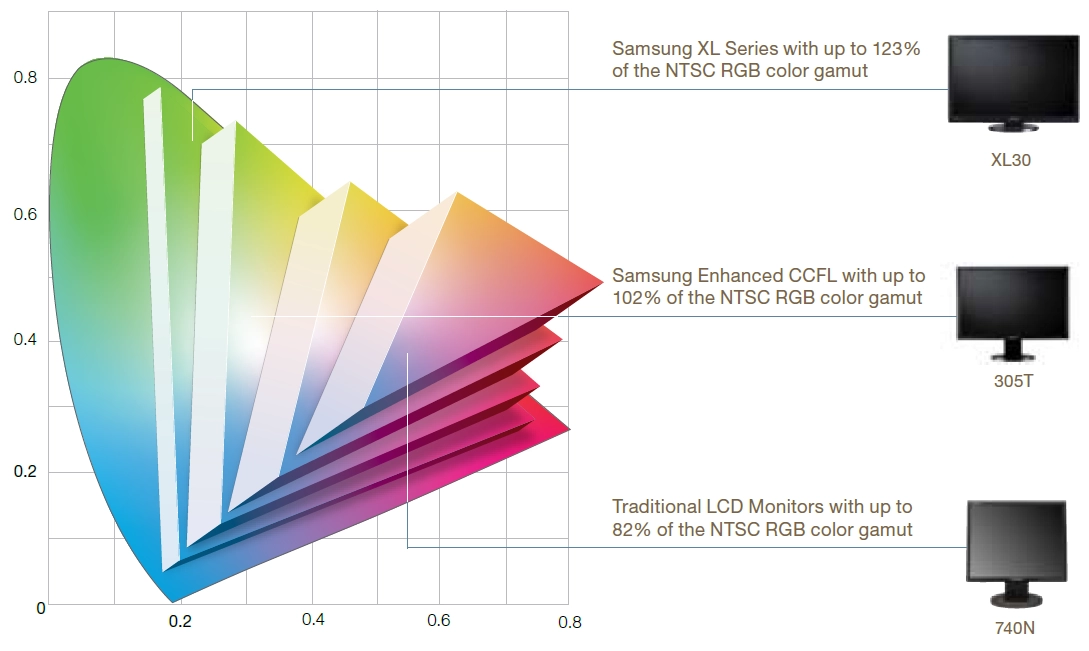
RGB-LED's considerable colour gamut
WLED – a modern approach
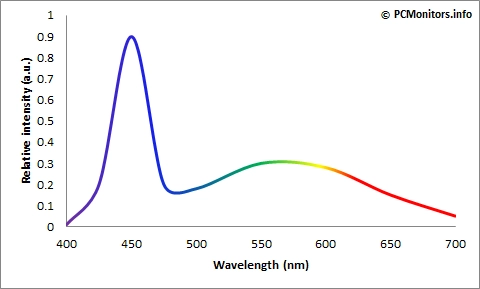
Typical WLED spectrum
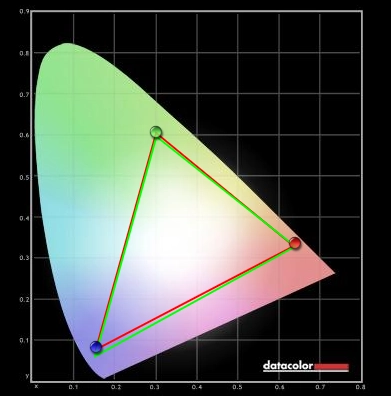
Typical WLED colour gamut
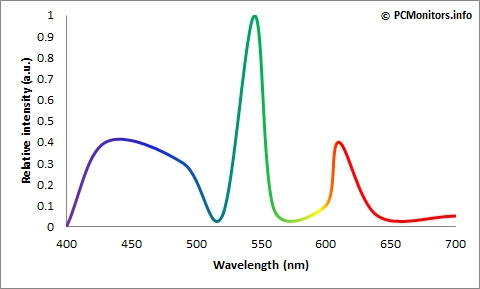
Typical CCFL spectrum
Looking past blue diodes
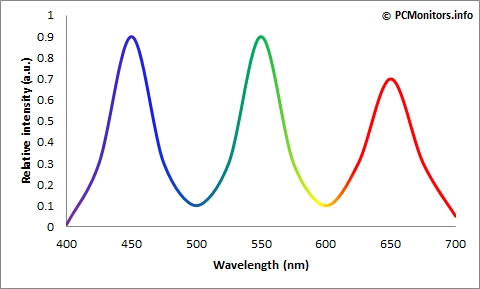
Typical GB-LED spectrum
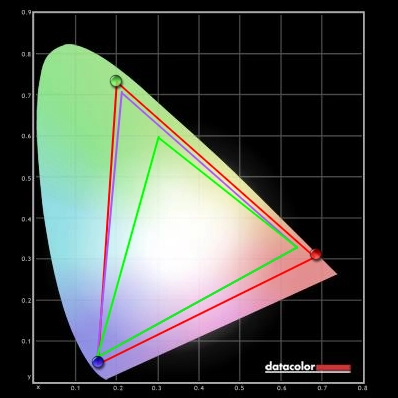
Dell UP2716D colour gamut
Improving the phosphors
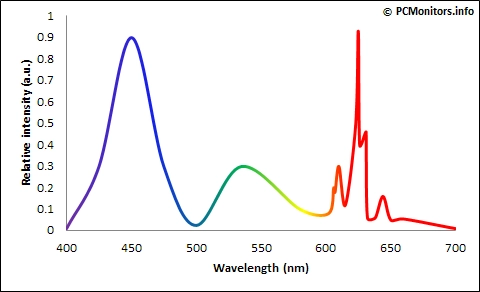
KSF (Nano IPS) spectrum
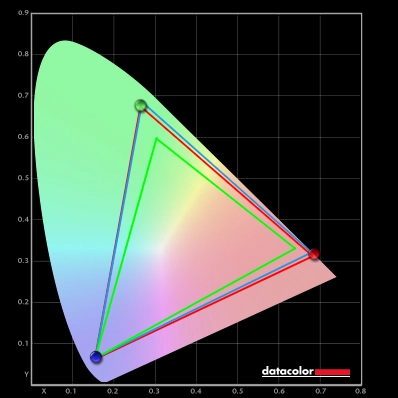
KSF (Nano IPS) colour gamut - XG270QG
Similar enhanced phosphors are used to great effect on other models, including some relatively affordable models. See for example the colour gamut achieved by the AOC 24G2(U) (below) with its enhanced (KSF) phosphor WLED backlight. Not quite as wide as the Nano IPS implementations in this case, but certainly offering generous extension beyond sRGB.

KSF colour gamut - 24G2(U)
Samsung and various other panel and CELL (panel without backlight) manufacturers such as AUO will sometimes use alternative means to achieve enhanced colour gamuts. An alternative technology has been developed and is being further developed by a US-based company called Nanosys. The technology is called ‘Quantum Dot Enhancement Film’ (QDEF), with the backlights often referred to as QD LED (Quantum Dot LED) rather than having the Nanosys nomenclature attached. Blue diodes are still used, but the phosphor coating and diffuser are replaced with a special film of nanoscopic phosphors called ‘Quantum Dots’ as illustrated below.
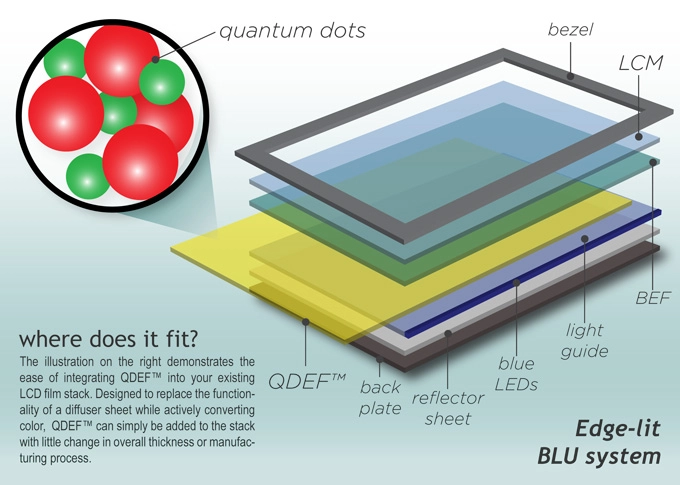
QDEF - Quantum Dot Enhancement Film

Nanosys QD spectrum
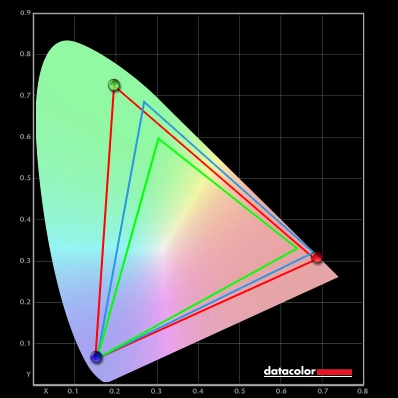
QD LED colour gamut - XB323U GP
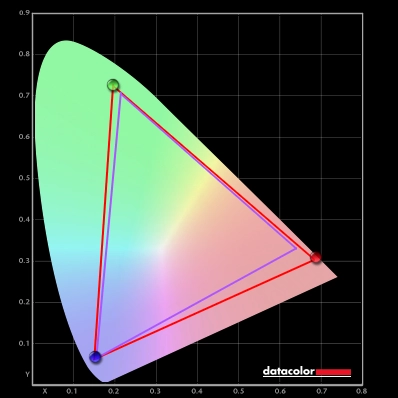
QD LED colour gamut - XB323U GP vs Adobe RGB
Making use of those extra colours
Conclusion

Quantum Dots


